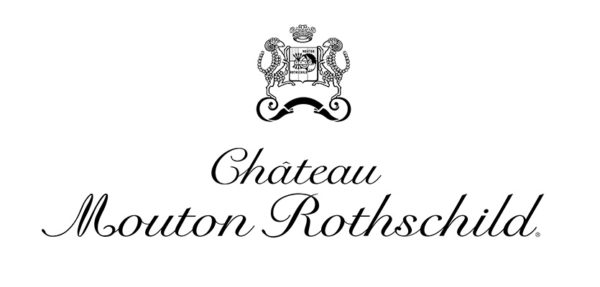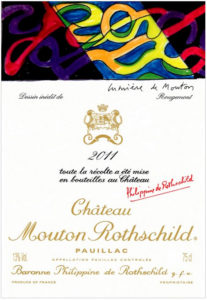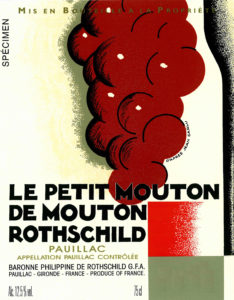
The Estate
The name “Mouton Rothschild” has 2 origins. “Mouton” is translated to “small hill,” which is a reference to the terroir on which the estate is planted. “Rothschild” or “Red Shield” was derived from the house where a Rothschild ancestor lived in Frankfurt. The Rothschild family were merchants in the mid-18th century, and having made a fortune in their family business, in 1853 they purchased the Brane Mouton chateau in Bordeaux. Brane Mouton was renamed Mouton Rothschild, and extensive replanting was commenced as the vines were in a poor state.
In the early 1920s, the very young Baron Philippe Rothschild assumed control of the estate and proceeded to influence how Bordeaux wine would be made and sold for years to come. In the original 1855 Classification, Mouton Rothschild was awarded Second Growth status. Spurred by his great desire to earn First Growth status for Mouton Rothschild, in the astonishingly short period of 2 years the Baron made several innovations. First, he introduced the practice of estate bottling which was highly unusual at the time. This gave him total control over his product, at a time when wine was typically sold in barrels to négociants who would handle the bottling. Second, he also began the tradition of hiring an artist to design the wine labels, beginning in 1924 with Cubist artist Jean Carlu. Carlu was succeeded by many famous artists over the years, such as Dali, Miro, Chagall, Braque, Picasso, and Warhol. Third, Baron Philippe was also the first to create a branded wine that was world renowned and sold at a reasonable price for consumers.
Since the estate was now bottling their wine on premise, this created a need for more storage space, and so in 1926 the young Baron began construction of the famous “Grand Chai” of Mouton Rothschild.
He also added to the estate holdings in 1933, with the purchase of Château Mouton d’Armailhacq (later Chateau d’Armailhac), and in 1970 with the purchase of Chateau Clerc Milon.
Eventually, after many years of hard work and dedication, Baron Rothschild finally succeeded in changing the 1855 classification of Mouton Rothschild to First Classified Growth, the first person to ever do so.
Baroness Philippine de Rothschild, daughter of Baron Philippe, succeeded her father in 1988 who passed away that year.

Château Mouton Rothschild Pauillac 1er Grand Cru Classé
Production Area: 75 hectares
Grape Varieties Planted: 80% Cabernet Sauvignon, 16% Merlot, 3% Cabernet Franc, and 1% Petit Verdot (percentages vary depending on the vintage)
Terroir: Gravel, rocks, sand, clay, and limestone. The gravel goes as far as 5 meters below ground.
Average Age of the Vines: 50-100 years old, with the oldest vines being planted in 1890
Plant Density: 10,000 vines per hectare
Location: The vines are situated on the “Mouton plateau,” or the “Grand Plateau,” a small hill that rises about 29 meters above sea level, one of the highest elevations in Pauillac. They are planted mostly in one large block. Lafite Rothschild lies just to the north, and Pontet-Canet is their immediate neighbor next door.
Vineyard: The same people work the same vineyard plots every year to ensure special care of the vines. The vines are tied after they are pruned. The young plants are trained in the spring to allow the tractors to pass through and work the soil. Green harvesting and crop thinning are sometimes practiced.
Harvest: Manually picked into 12 kilo open baskets. The young vines are harvested first and are fermented separately. The grapes are sorted by hand before destemming.
Vinification: In temperature-controlled, 225-hectoliter wooden vats. Malolactic fermentation takes place in tank.
Aging: 100% new, French oak barrels for 19-22 months.
2003 Reviews: “…the nose offers up notes of cedarwood, roasted coffee, tobacco leaf and red and blackcurrants…spicy, earthy, fleshy, medium to full-bodied…” – 91pts, Robert Parker

Le Petit Mouton de Mouton Rothschild
Overview: Produced from an exceptional terroir, Le Petit Mouton de Mouton Rothschild is the second wine of Château Mouton Rothschild. Made with grapes from selected younger vines in the illustrious First Growth vineyard, it is harvested, vinified and bottled with the same scrupulous attention to detail. Harvested in small, open baskets, fermented in the Mouton oak vats, matured in oak barrels in the traditional way, all the conditions are met for the wine to express the elegance and richness of a great Pauillac. In order to link the second wine more closely with its famous elder, illustrated by great artists since 1945, Baroness Philippine de Rothschild has chosen a label for Le Petit Mouton inspired by a drawing by the famous poster artist Jean Carlu. The first vintage, 1993, was called Le Second Vin de Mouton Rothschild, but it has borne its definitive name (which has a family connotation, Petit Mouton being the name of Baroness Philippine’s residence in the heart of the estate) since the following year, 1994.
Grape Varieties Planted: 80% Cabernet Sauvignon, 16% Merlot, 3% Cabernet Franc, and 1% Petit Verdot (percentages vary depending on the vintage)
Terroir: Gravel, rocks, sand, clay, and limestone. The gravel goes as far as 5 meters below ground.
Average Age of the Vines: 50-100 years old, with the oldest vines being planted in 1890
Plant Density: 10,000 vines per hectare
Location: The vines are situated on the “Mouton plateau,” or the “Grand Plateau,” a small hill that rises about 29 meters above sea level, one of the highest elevations in Pauillac. They are planted mostly in one large block. Lafite Rothschild lies just to the north, and Pontet-Canet is their immediate neighbor next door.
Vineyard: The same people work the same vineyard plots every year to ensure special care of the vines. The vines are tied after they are pruned. The young plants are trained in the spring to allow the tractors to pass through and work the soil. Green harvesting and crop thinning are sometimes practiced.
Harvest: Manually picked into 12 kilo open baskets. The young vines are harvested first and are fermented separately. The grapes are sorted by hand before destemming.
Vinification: In temperature-controlled, 225-hectoliter wooden vats. Malolactic fermentation takes place in tank.
Aging: 100% new, French oak barrels for 19-22 months.


